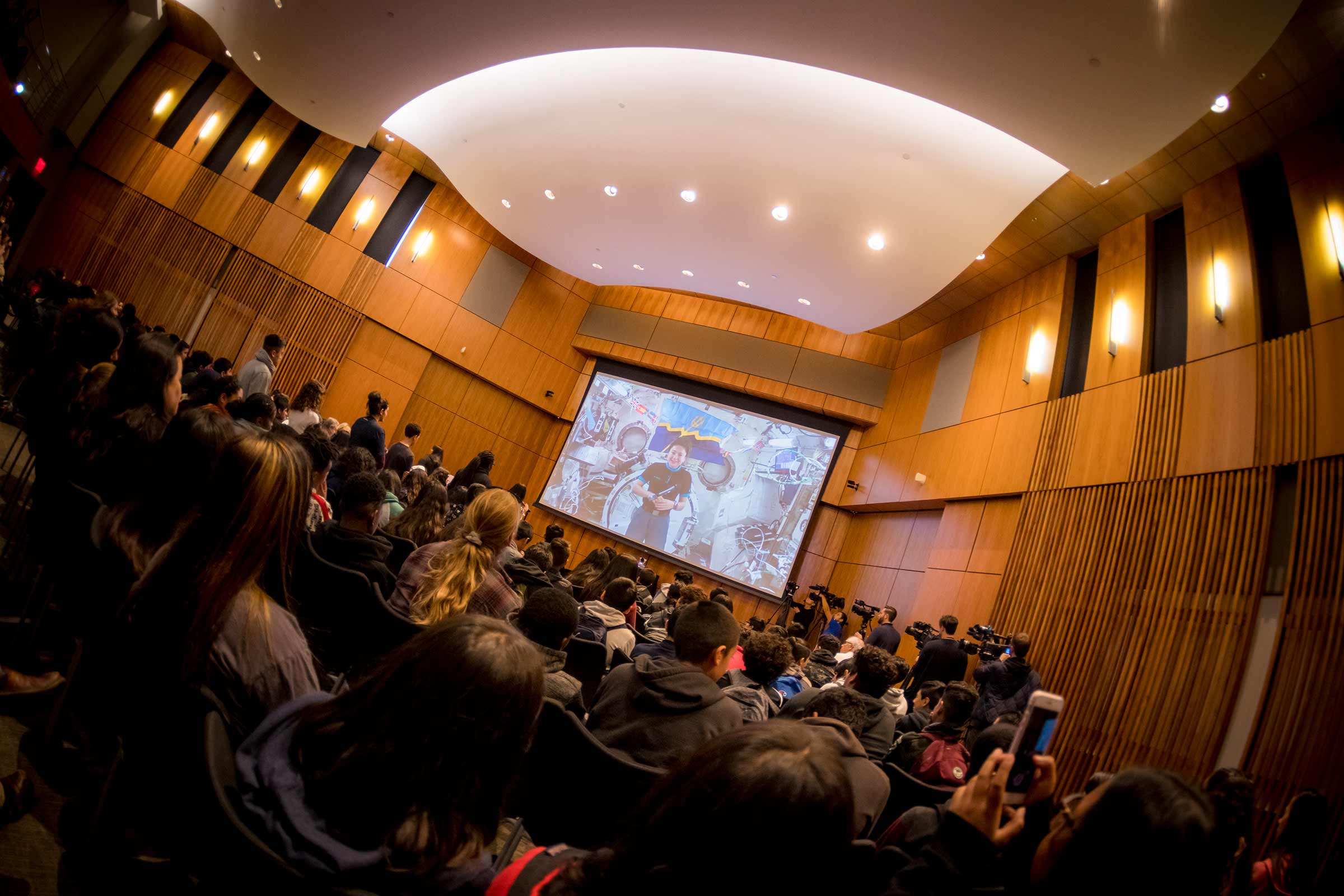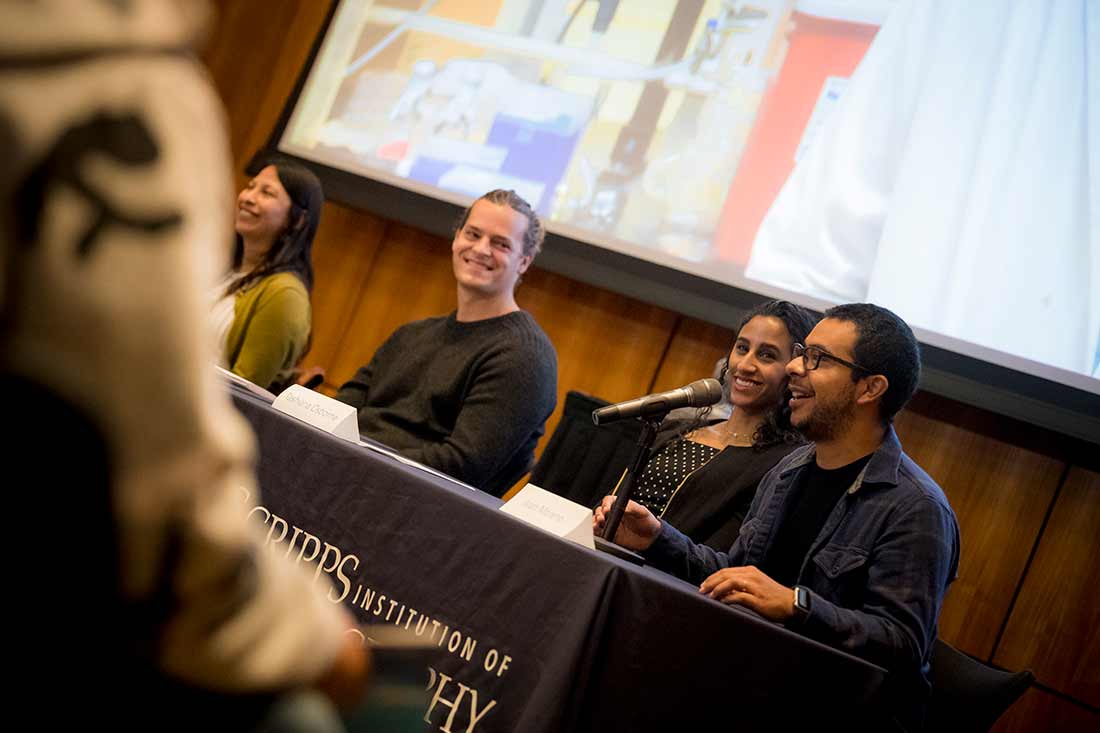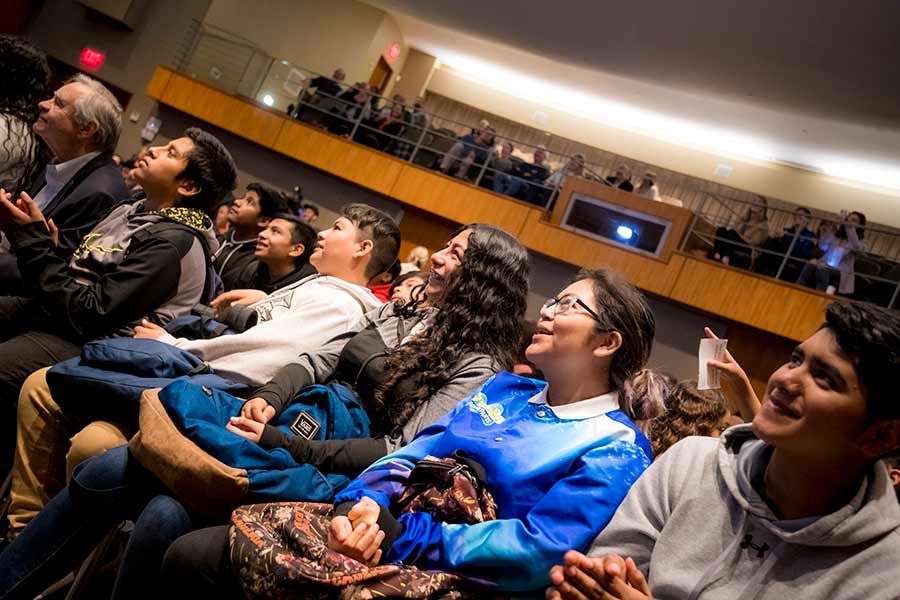By:
- Brittany Hook
Published Date
By:
- Brittany Hook
Share This:
An Out of This World Conversation with Astronaut Jessica Meir
UC San Diego alumna discusses her journey from ‘STEM to Stars’ during live Q&A from International Space Station

NASA astronaut and UC San Diego alumna Jessica Meir called her alma mater from space to participate in a live stream Q&A session at the Scripps Seaside Forum. Photos by Erik Jepsen/UC San Diego Publications
It’s not every day that you are given the chance to talk to an astronaut, let alone one that’s currently residing at the International Space Station 250 miles above Earth. But the doors of possibility were kicked wide open on Jan. 27, when Scripps Institution of Oceanography at UC San Diego welcomed more than 150 middle school students to campus for the opportunity to engage in a live Q&A session with NASA astronaut and UC San Diego alumna Jessica Meir.
The Scripps Seaside Forum was buzzing with anticipation as eighth grade students from Fulton K-8 and Memorial Preparatory for Scholars and Athletes, two schools supported by Birch Aquarium’s Price Philanthropies Ocean Science Education Fund, waited for the chance to ask Meir their burning questions. UC San Diego astrophysicist Brian Keating emceed the event, which was also attended by Meir’s friends, mentors, and former Scripps colleagues. Thousands more tuned in remotely via live stream and through a special viewing at Birch Aquarium.

Scripps graduate students Anai Novoa, Kiefer Forsch, Tashiana Osborne, and Ivan Moreno participate in a pre-event science panel, sharing their path to science with local eighth graders.
The theme of the event was “STEM to Stars,” a nod to Meir’s trailblazing path from ocean science to space. A trained marine biologist, Meir earned her Ph.D. in 2009 from Scripps Oceanography, where she studied the physiology of deep-diving animals in extreme environments. She credits this research with helping her stand out for NASA’s astronaut program. Since launching to the International Space Station in September 2019 for a six-month mission, Meir has conducted three spacewalks, making history in October 2019 when she and astronaut Christina Koch conducted the world’s first all-female spacewalk.
Prior to the live stream, the visiting students heard from four current Scripps graduate students in a pre-event science panel. The students—Kiefer Forsch, Ivan Moreno, Anai Novoa, and Tashiana Osborne—discussed what they research at Scripps, what it’s like to be a graduate student, their path to science, and challenges they’ve overcome. Graduate students from the Scripps group Women & Minorities in Science (WMIS) also participated in the event, showcasing hands-on research demos in the main lobby.
Kicking off the main event, Keating told the students some fun facts about Meir’s adventures in space. “When she’s in space currently, she’s traveling about 5 miles per second; she gets to witness sunrise and sunset 16 times a day, but I bet it never gets old for her, and she’s traveling many thousands of miles an hour,” he said, explaining that it only takes 90 minutes for Meir to travel the entire circumference of Earth.
Scripps Director Margaret Leinen also spoke to the students, describing some of the amazing places science can take you, whether here on Earth or up in space, and she congratulated Meir for utilizing her love of science to reach the stars.

Eighth grade students from two San Diego schools, Fulton K-8 and Memorial Preparatory for Scholars and Athletes, attend the live stream Q&A event with astronaut Jessica Meir.
“I want to make sure you know how proud we are of everything that you’ve done with this extraordinary background in oceanography, and being able to realize this dream of yours to go to space,” Leinen said.
Ashley and Alicia, two eighth graders from Memorial Preparatory, were among the lucky students who got to ask Meir a question.
“Her being up in space shows us that mostly anything is possible. As long as you try your best, then you can succeed,” said Ashley, who plans to one day be a software developer.
Alicia said she felt honored to talk to Meir and was inspired by her determination to pursue something that she really loves.
“She inspired me to want to do my best, and even if I know I am doing my best, to try even harder, because there’s always a good outcome,” Alicia said. Even though she plans to pursue a career outside of STEM, she said she hopes to learn more about science because “it never hurts to know more.”
Below is an excerpt from Meir’s Q&A session, condensed and edited for clarity. View the full livestream on Facebook and YouTube.
Q. Were you afraid of the takeoff? - Andres (Memorial Preparatory)
A. I wasn’t afraid, actually, and I think one of the reasons why we don’t really have that fear response, or at least I didn’t, is because we receive so much incredible training at NASA. I have been training for my mission up here for six years, so we have been over and over all of the different things that we’ll be experiencing.
In the last two years, I spent a lot of time in Russia training with the Russian space program since we launched to space on the Soyuz rocket. We spent a lot of time in simulators, preparing for every step and every phase of the mission. So, it was really interesting. I had been through that so many times in a simulator, which looked exactly like the real thing, that sometimes during the actual liftoff, I had to remind myself that this was finally real. You get so immersed in what you’re doing and so focused with all the steps and actions you have to take as an operator, that sometimes you forget that it’s not just the same as all the practice you’ve been doing.
There were a few not so subtle reminders though, when the rocket started groaning and shifting a little bit, and then as the different stages of the rocket separated and we got higher and higher away from the earth, you could actually see those things falling off of the rocket outside of the window. Once I started seeing those signs I realized it was true, but it really wasn’t any sort of fear; it was really just excitement and a little bit of disbelief and incredulity that my dream was actually finally coming true.
Q. What kind of classes did you take in school that helped you become an astronaut? - Ariana (Fulton K-8)
A. The common theme in everything we do up here is the STEM field—science, technology, engineering, and math. Now the nice thing is, there are a lot of different options within those fields. All of those fields could lead to a career like this one. To become an astronaut, you do have to have a degree in one of those areas, but the choices are really broad. For example, I’m a life scientist, a biologist, and physiologist, and up here with me on my crew there’s an electrical engineer, there’s a military doctor, there’s a military test pilot with a background in engineering, and then our two Russian cosmonauts up here as well with their engineering and military backgrounds. All of these different backgrounds are basic paths that you can use to get up here, so spending time in any of those STEM courses really helped us all get where we are today.
Q. What type of research do you do on the space station? Do you do any experiments outside the space station? - Naomi (Fulton K-8)
A. It’s really amazing how many different types of experiments we conduct up here, and as a scientist, it is so exciting because as you can imagine, once you eliminate these gravity-driven effects that are always present no matter where you are on the earth, you might unveil a whole variety of responses and results that we never even thought possible. So we do experiments ranging from physiology and medicine, how the space flight environment affects our human bodies; we do experiments about combustion—even flames burn differently in space without gravity, without convection driving that motion. So in a chamber we study how different things burn in terms of flammability and safety responses, also in terms of fuel efficiency that might enhance fuel efficiency on earth and also for future spacecraft. We do biotechnology experiments; I did a DNA sequencing experiment called “Genes in Space” up here, and we do fluids experiments. We do any type of experiment and it is really an amazing playground as a scientist to be up here.
I was fortunate enough to go outside the space station three times now on spacewalks, and those are actually not for scientific experiments; those are for repair jobs. We have hardware both inside and outside the space station that’s critical to making sure the systems work up here to accomplish our mission, and one of the things that needed to be upgraded were our batteries. So we conducted a series of spacewalks to upgrade those batteries to more efficient lithium ion batteries, just like you’re using down on Earth. And that was one of the most amazing things that I’ve done while I’m up here is venturing out of the hatch in a spacesuit, and having really nothing between you and the earth below, except for the visor of your helmet. It really is an extraordinary experience.
Q. What advice do you have for young women who want to be astronauts? - Alma Renero (Instagram)
A. I think the most important thing to do is to make sure that you identify your passion and do what it is that you really care about. Once you’ve done that, you do need to work really hard to make those dreams come true, and it sounds a bit trite when I say it, but it really is true! I think this is proof that your dreams can come true. I’ve been saying I wanted to be an astronaut since I was 5 years old, and because I had identified that as my passion, and also identified other aspects of science and exploration that led me down that road and pursued it—with a lot of hard work and dedication and perseverance—and then a lot of luck, all wrapped together to actually get me where I am today. The point is really, anybody can do it if that’s what you set your mind to.
Q. Before you got accepted as an astronaut, did you ever consider any other careers? Jhiana (Fulton K-8)
A. Well I certainly did! I had a whole other career and that is thanks to Scripps Institution of Oceanography and UC San Diego and all of the mentors and colleagues that I had during my time as a graduate student there. My time at Scripps was invaluable; it really taught me how to think as a critical thinker, how to form and conduct something efficiently using the scientific method, and most importantly—relevant to my job today—it taught me a lot about working with a team.
I was working as a comparative physiologist so I was studying animals, in particular animals that live in extreme environments, and trying to understand how those animals can do the incredible things they can. I was particularly intrigued by animals that live and work at extraordinary depths, so diving animals like emperor penguins, and elephant seals, and also high-altitude animals, birds that migrate over the tallest mountains on the planet. It was just fascinating to understand how these animals could live in these very oxygen-deprived zones.
I was working as a scientist at various universities and academia conducting research with animals in the wild and it was a very fulfilling career, but when the opportunity came to have this childhood dream job, I couldn't pass this up.
Stay informed about Meir’s latest activities by following her on Twitter and Instagram.
Share This:
You May Also Like
Engineers Take a Closer Look at How a Plant Virus Primes the Immune System to Fight Cancer
Technology & EngineeringStay in the Know
Keep up with all the latest from UC San Diego. Subscribe to the newsletter today.



